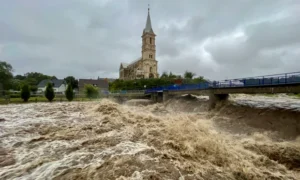How do we know that the climate crisis is to blame for extreme weather?
{Earth and Leaf Editorial – climate crisis is to blame for extreme weather}
{extract below}

How do we know that the climate crisis is to blame for extreme weather?
It is a crucial question: is the climate crisis to blame for the extreme weather disasters taking lives and destroying homes around the world. But it has not been an easy one to answer. How much is due to global heating, how much is just the severe weather that has always happened?
The good news is that the scientific techniques used to untangle that question – called climate attribution – are now well established. The bad news is what they reveal: the studies show that the burning of fossil fuels has changed the climate so dramatically that heatwaves, floods and storms are now hitting communities with a severity and frequency never seen during the entire development of human civilisation.
What are attribution studies?
There are three approaches, used in combination to give the most reliable results. All compare the present with the past in order to calculate the increased frequency or severity of events. Weather data from the overheated present and the cooler past, when available, can be compared to see how many times more an extreme event happens today. Climate models can be used in a similar way to compare modern and preindustrial climates. Thirdly, climate models can also simulate the climate from, say, 1900 to the modern day, with slowly rising human-caused emissions. This enables scientists to detect trends in extreme weather, as well as the overall change in likelihood.
What have the studies found?
The most striking findings are of extreme heatwaves that would have been impossible without global heating, because they have no historical precedent and do not happen in model simulations without the added heat from human-caused climate change. That is as close to saying global heating caused the heatwave as makes no difference. At least 24 previously impossible heatwaves have already struck around the world, from Europe to North America, Africa and east Asia. {The climate crisis is to blame for extreme weather}.
What about other events?
Many more extreme weather events have been made significantly worse, or more likely, by global heating. That means hotter heatwaves, more intense rains, stronger gale-force winds. Of the 744 attribution studies in a database produced by Carbon Brief, the most comprehensive that exists, three-quarters found that global heating had a significant impact.
It is a crucial question: is it that the climate crisis to blame for the extreme weather disasters taking lives and destroying homes around the world. But it has not been an easy one to answer. How much is due to global heating, how much is just the severe weather that has always happened?
The good news is that the scientific techniques used to untangle that question – called climate attribution – are now well established. The bad news is what they reveal: the studies show that the burning of fossil fuels has changed the climate so dramatically that heatwaves, floods and storms are now hitting communities with a severity and frequency never seen during the entire development of human civilisation.
What are attribution studies?
There are three approaches, used in combination to give the most reliable results. All compare the present with the past in order to calculate the increased frequency or severity of events. Weather data from the overheated present and the cooler past, when available, can be compared to see how many times more an extreme event happens today. Climate models can be used in a similar way to compare modern and preindustrial climates. Thirdly, climate models can also simulate the climate from, say, 1900 to the modern day, with slowly rising human-caused emissions. This enables scientists to detect trends in extreme weather, as well as the overall change in likelihood.
What have the studies found {- is it that the climate crisis is to blame}?
The most striking findings are of extreme heatwaves that would have been impossible without global heating, because they have no historical precedent and do not happen in model simulations without the added heat from human-caused climate change. That is as close to saying global heating caused the heatwave as makes no difference. At least 24 previously impossible heatwaves have already struck around the world, from Europe to North America, Africa and east Asia. {The climate crisis is to blame for extreme weather}.
What about other events?
Many more extreme weather events have been made significantly worse, or more likely, by global heating. That means hotter heatwaves, more intense rains, stronger gale-force winds. Of the 744 attribution studies in a database produced by Carbon Brief, the most comprehensive that exists, three-quarters found that global heating had a significant impact.